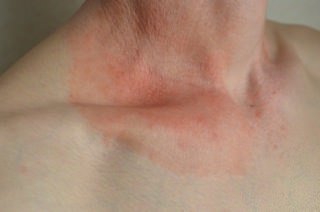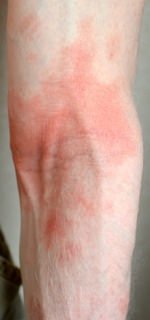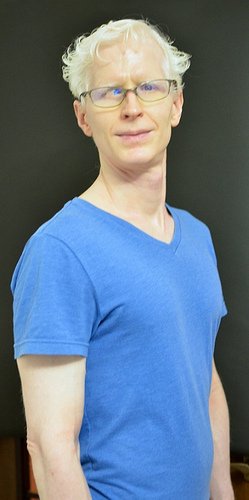How I got dermatitis, and recovered!
Here’s me a few days ago, nearly free of the itchy and ugly dermatitis.
This story has some connection to my recent post about how Primal living has improved my life. I hope that it might provide some help to anyone else who is suffering from this condition. Also, if you’re reading this and thinking that you’re pushing it really hard with work, and feeling stress, I hope it may encourage you to slow down, relax, and get more sleep, to avoid problems like this.
Warning: Anyone who doesn’t want to see pictures of irritated skin had better stop reading now and not scroll down.
How I got dermatitis
For about six months, from October of last year through March of this year, I was quite busy with work, including several business trips across many time zones (from Japan to Europe and the States). Sometimes I’d have less than two weeks to recover from the jet lag before the next long haul trip. I’d just had more coffee and kept going.
Sometime around October, I noticed a small red spot on my neck, that was irritated. I didn’t think much of it, until it started getting bigger, and I noticed that I was sometimes scratching it. By December, while on another trip, it was getting annoying. I kept applying some over-the-counter anti-itch cream (hydrocortisone), which helped some, but clearly did not heal the problem.
By February, I had a big red spot on my neck. Then, after a conference ended, knowing that I had to fly back to Japan the next day, I foolishly stayed out nearly all night with my friends and colleagues. It was a fun night, but I really paid for it. Even though I hadn’t had so very much alcohol, I was so tired the next day that I dozed off on the plane several times, despite drinking coffee. Usually, I stay awake on flights, which I find helps me to get to sleep after arrival, so that I adjust faster to the new time zone. Somehow I made it home, feeling super tired but OK.
That night I noticed that I had a red spot on my left arm, too. The next day, after eating some fruit, I had an outbreak of cold sores on my mouth. I couldn’t remember having those since I was a child. I also had a bad case of dandruff. I also had a bad case of dandruff. At that point my wife got really worried and told me that I had to go to see a doctor.
What it looked like
These were taken in early May, 2016.



What the doctors said
First I saw two dermatologists, and both prescribed topical steroids. One gave me moisturisers, too. They all diagnosed dermatitis, but neither of them seemed to have any idea what caused it.
I knew that using lots of topical steroids for extended periods can have bad side effects, and the more I thought about it the more I felt determined to do something about the underlying cause, not just the symptoms.
On the internet I of course found a wide variety of opinions and recommendations. Was it caused by leaky gut, adrenal fatigue, fungus? I couldn’t tell. But, I knew that the fatigue from too much travel had somehow caused my problem. I also suspected that too much caffeine was part of the problem.
Then my lovely wife and I searched the internet and found a highly recommended dermatologist in Tokyo who was not determined to treat every skin disorder with topical steroids. This is quite rare in Japan, and in the US from my experience. So, I went to see him even though it was nearly a two hour trip, one way.
Dr. Shigeki Fujisawa prefers to use only what medication is necessary. He quickly diagnosed me with seborrheic dermatitis. His first recommendation was to reduce my carbohydrate intake. I told him that I had already been eating low carb (Primal) for several years. He recommended cutting out all alcohol and even rice, which I’m sure would seem quite extreme to most people in Japan.
Over the next few weeks we tried an anti-fungal cream and then an antibiotic, neither of which helped significantly. I did notice that after I stopped drinking alcohol (before I would often have a glass of wine, often two, with dinner any given night) it got a little better. Then we tried a cream made from soybeans, which is made to mimic coal tar. (It mimics the smell, too, which is not so nice.) That helped more than anything had yet. Still, I wasn’t recovering particularly quickly. The last, and most effective, thing we tried was pine tar. That really helped, and it didn’t smell as bad as the other stuff.
What else I tried, and how it worked (or didn’t)
Of course I didn't just apply the medicines and leave it at that. Those who believe that dermatitis (among many other problems) are usually caused by leaky gut, or adrenal fatigue, say that it takes at least a few months to recover from those conditions. This seemed like waaay toooo loooong! But, I had already tried the topical steroids for a little while. They didn’t solve the problem, and I was determined not to use them long-term.
Low-carb diet and fasting, quite effective
I kept to a very low carb diet and tried fasting for 2-3 days a few times. Fasting was surprising easy, as reported by many others who are used to a low carb diet, and it so obviously reduced the inflammation during the fast. However, the redness returned once I started eating again. Still, it was an interesting experiment, and I think there may be something to the idea that fasting once in a while, to imitate our prehistoric ancestors, should be good for us humans.
Rest and exercise, quite effective
I cut back on my work schedule and got more sleep. Then, probably about a month after that the redness was getting better, and I started to feel better in general. At that point I got back into the gym and started exercising a few times a week, including some moderately heavy lifting, like push-ups, pull-ups, etc. It surprised me how much that helped. I had read and heard that exercise, particularly heavy lifting, and sleep can boost testosterone levels in men, which tends to make us healthier in general. So, I looked into that more.
I learned that pineapples and bananas contain a chemical called bromelain, which is supposed to help raise testosterone levels. (Some people make some pretty hard to believe claims about how a ‘pineapple diet’ can help for losing weight, but I wasn’t even interested in that.) I did try adding more of those two fruits to my diet. I don’t know how much that helped, or if it was mostly the exercise. I do know that after a month or so of better rest and exercise I was clearly getting a lot better, without using any topical steroids.
Cutting back on caffeine, helped
I think it probably helped most by allowing me to relax and get better sleep. Many people recommend cutting back on caffeine for ‘adrenal fatigue’. I don’t know if that was my problem, but I’m confident that I had been having way too much caffeine, particularly when I was travelling so much. So, I figured it was worth trying to reduce it. What surprised me was that I sometimes wanted a cup of coffee much more than I ever wanted a glass of wine. I had been used to having coffee daily, and wine at least several times a week. Caffeine is a powerful drug!
Eating an anti-inflammatory diet, helped
This means low intake of grains, sugars, and even sweet fruits, because carbohydrates do cause inflammation. I also ate more sardines and other cold water fish, which are rich in anti-inflammatory omega-3 fatty acids. I ate moderate amounts healthy nuts, including almonds, pistachios, walnuts, and pecans, too.
Anti-dandruff shampoos, helped
Dr. Bronners soap, probably helped
Many people recommend this pure and simple soap, and report that it helps with dermatitis. It doesn’t contain the additives that lots of soaps do.
Oils, not so effective
During this ordeal I also tried applying a variety of oils, including coconut oil, which I had long been using as a moisturiser. I also tried mixing in some lavender and peppermint oils. That was sometimes mildly irritating, and it didn’t seem to help.
Moisturisers, made it worse
Dr. Fujisawa and others recommend that its best to let the skin moisturise itself, rather than become dependent on topical moisturisers. Also, sometimes I noticed that irritated areas on my face actually felt more painful after I applied moisturisers. So, I soon stopped using them.
Anyway, after about 5 months, I feel healed!
I still have the slightest of red spots on my arms and neck, but hardly any more than I might have had any given summer in the heat and humidity of central Japan.
And I learned a few things
Although it wasn’t a pleasant experience, I did learn things about myself. Probably most important is that even though I feel strong and generally healthy, I do have limits that I shouldn't keep pushing for extended periods.
I appreciate even more than before the importance of eating (and drinking) well. Most days I just drink decaf and herbal teas. I like that I have plenty of energy without caffeine. Some days I’ll have one cup of regular coffee. I have a little wine once in a while, too, but not as much as before.
S. Lan Smith
Kamakura, Japan
August 22, 2016

I am not sure if its a universal medicine against seborrheic dermatitis, but try out apple cider 5% mixed with water on your skin for a few minutes.
Thanks. That I haven't tried. Fortunately, I think I'm already done with the dermatitis.
lanimal - I would love to connect with you. I know this post is 5 years old. I have been struggling with a similar dermatitis problem for the last 3 years. Please respond here if you are still active.